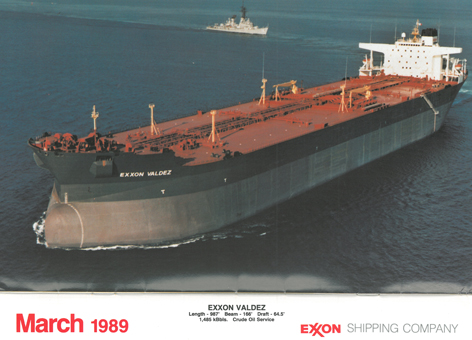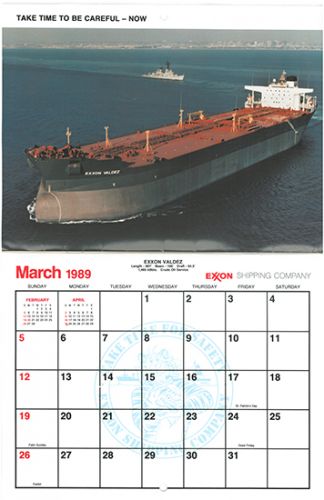Looking Back: What Led up to the Exxon Valdez Oil Spill?
MARCH 12, 2014 -- The Exxon Valdez oil spill occurred on March 24, 1989. This spill was a turning point for the nation and a major event in the history of NOAA’s Office of Response and Restoration. It also led to major changes in the federal approach to oil spill response, and the technical, policy, and legal outcomes continue to reverberate today. But before this monumental oil spill happened, there were a series of events around the world building up to this moment. Now, 25 years later, join us for a look at the history which set the stage for this spill.
1968
Atlantic Richfield Company and Humble Oil (which would later become Exxon) confirmed the presence of a vast oil field at Prudhoe Bay, Alaska. Plans for a pipeline were proposed but held up by various environmental challenges.
1973
The 1973 oil embargo plunged the nation into a serious energy crisis, and Alaskan oil became a national security issue. On November 16, 1973, President Richard Nixon signed the Trans-Alaska Pipeline Authorization Act, which prohibited any further legal challenges. This pipeline would connect the developing oil fields of Alaska with the port town of Valdez, where oil could be shipped out on tankers through the Gulf of Alaska.
1977
On August 1, 1977, the tanker ARCO Juneau sailed out of Valdez with the first load of North Slope crude oil.
1981
How prepared for oil spills was Valdez? Despite complaints from the State of Alaska, Alyeska Pipeline Service Company, the corporation running the Trans-Alaska Pipeline, decides to disband its full-time oil spill team and reassign those employees to other operations.
1982
The National Contingency Plan (NCP) is updated from the original 1968 version, which provided the first comprehensive system of accident reporting, spill containment, and cleanup in the United States. The 1982 revisions formally codified NOAA's role as coordinator of scientific activities during oil spill emergencies. NOAA designated nine Scientific Support Coordinators, or SSCs, to coordinate scientific information and provide critical support to the U.S. Coast Guard, and other federal on-scene commanders.
1984
In May 1984, Alaska Department of Environmental Conservation (DEC) field officers in Valdez write a detailed memo warning that pollution abatement equipment has been dismantled and Alyeska, the pipeline company, does not have the ability to handle a big spill. This document will become part of the Congressional investigation of the Exxon Valdez oil spill. Later in 1984, Alyeska conducts an oil spill response practice drill that federal and state officials deem a failure. In December 1984, DEC staffers in Valdez write another lengthy memo to their administrators detailing shortcomings in Alyeska's spill response program.
1986
The T/V Exxon Valdez is delivered to Exxon in December of 1986 and makes its maiden voyage to Alaska. When the Exxon Valdez first arrived at the Port of Valdez later that month, the town celebrated its arrival with a party. "We were quite proud of having that tanker named after the city of Valdez," recalls former Mayor John Devens.
1987
Captain Joseph Hazelwood becomes master of the Exxon Valdez, which then earns Exxon Fleet safety awards for 1987 and 1988. In June 1987, the Alaska Department of Environmental Conservation approves Alyeska's contingency plan without holding another drill. The plan details how Alyeska would handle an 8.4 million gallon oil spill in Prince William Sound. Alyeska says:
"It is highly unlikely that a spill of this magnitude would occur. Catastrophic events of this nature are further reduced because the majority of tankers calling on Port Valdez are of American registry and all of these are piloted by licensed masters or pilots."
1988
The big news in Alaska is the lingering low price of oil. Nearly one in 10 jobs disappears from the Alaska economy. Oil output peaks on the Trans-Alaska Pipeline at 2.1 million barrels of oil a day.
January 1989
In January 1989 the Valdez terminal has a couple major tests of spill response capacity with two small oil spills, which draw attention to cleanup problems and the condition of their tanker fleet. Alyeska vows to increase its response capacity and decides to buy a high-tech, 122-foot-long skimmer, at a cost of $5 million. The skimmer is scheduled for delivery in August 1990. The company also replaces four 21-foot response boats and arranges to purchase thousands of feet of extra boom for delivery later in the year.
March 1989
On March 22, the Exxon Valdez arrives at the Valdez Marine Terminal, Berth 5 and begins discharging ballast (water used for balancing cargo) and loading crude oil. Loading is completed late on March 23 and a little after 9:00 p.m. the tanker leaves Valdez with 53 million gallons of crude, bound for California. Early on March 24, 1989, a little over three hours after leaving port, the Exxon Valdez strikes Bligh Reef, spilling approximately 10.9 million gallons of oil into Prince William Sound.
Join us on March 24, 2014 at 12:00 p.m. Pacific/3:00 p.m. Eastern as we remember the Exxon Valdez oil spill 25 years later. Use Twitter to ask questions of NOAA biologist Gary Shigenaka and learn about this spill's impacts on Alaska's environment. Get the details.


 An official website of the United States government.
An official website of the United States government. 
